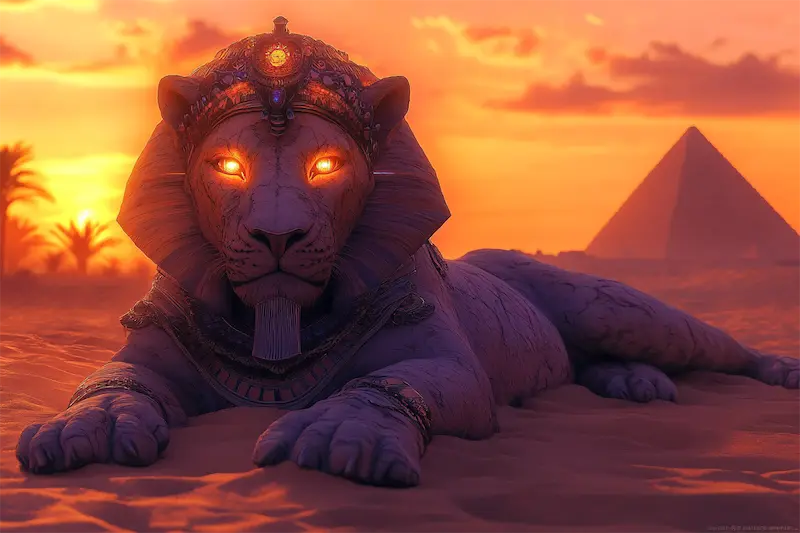- 1 What Is the Sphinx?
- 2 Appearance and Characteristics of the Sphinx
- 3 Origins and Symbolic Meaning of the Sphinx
- 4 Physical Traits and Powers of the Sphinx
- 5 Famous Myths Involving the Sphinx
- 6 The Sphinx in Modern Culture
- 7 Similar and Opposing Mythical Creatures
- 8 The Sphinx in Feng Shui and Symbolism
- 9 Conclusion
What Is the Sphinx?
The Sphinx is a mythical creature with origins in both ancient Egyptian civilization and Greek mythology. Known for its hybrid form—half human, half beast—the Sphinx typically has the head of a human and the body of a lion. It symbolizes power, intelligence, and a timeless sense of mystery.
In Egyptian culture, the Sphinx is a sacred figure guarding tombs and temples. In contrast, Greek mythology portrays the Sphinx as a cunning and dangerous creature that tests humans with deadly riddles. Though different in portrayal, both versions reflect the Sphinx’s significant role in ancient spiritual and cultural life.
Appearance and Characteristics of the Sphinx
The Sphinx is typically depicted with the body of a lion—representing dominance and power—and the head of a human, often female, signifying superior intellect and wisdom. Some versions also include eagle wings, adding a divine or supernatural element.
The most famous depiction is the Great Sphinx of Giza in Egypt. This colossal stone statue measures about 73 meters long and over 20 meters tall, featuring a pharaoh’s head and a lion’s body, guarding the entrance to the pyramids. Meanwhile, the Greek Sphinx has a more fearsome appearance—usually a winged woman with piercing eyes that can see into the soul.
Origins and Symbolic Meaning of the Sphinx
The origins of the Sphinx are rich and varied. In ancient Egypt, it was seen as the guardian of the pharaohs’ souls, representing supreme authority and divine wisdom. Egyptians believed the Sphinx stood at the threshold of the afterlife, blocking evil forces from disturbing the tombs of the dead.
Conversely, in Greek mythology, the Sphinx was a divine punishment sent by the gods—often by Hera or Ares—to challenge mankind. Its symbolism revolves around danger, superior intelligence, and the power to control fate through language and thought.
Physical Traits and Powers of the Sphinx
The Sphinx’s power lies not just in its physical strength, but also in its intellect. With the body of a lion, it could tear apart enemies with ease, but its most dangerous weapon was its riddles. In myths, the Sphinx would kill anyone who failed to answer its riddles correctly.
One of its most famous riddles is:
“What walks on four legs in the morning, two at noon, and three in the evening?”
The answer is “a human”—crawling on all fours as a baby, walking on two legs as an adult, and using a cane in old age.
This intelligence sets the Sphinx apart, making it a symbol of divine wisdom and the ultimate mental challenge for humankind.
Famous Myths Involving the Sphinx
The most well-known story of the Sphinx comes from Greek mythology and takes place in the city of Thebes. According to legend, the Sphinx was sent to Thebes and placed at its gates, posing riddles to all who passed. Those who failed to answer correctly were killed.
No one could solve its riddle until Oedipus came along. With calmness and insight, he answered the riddle correctly. Defeated, the Sphinx threw herself off a cliff. This victory not only saved Thebes but also led Oedipus to become king—marking the beginning of his tragic story, which remains one of the most famous in Greek literature.
The Sphinx in Modern Culture
Today, the Sphinx continues to fascinate people worldwide. The Great Sphinx of Giza stands as one of Egypt’s most iconic landmarks and a globally recognized archaeological wonder. In modern literature, film, comics, and video games, the Sphinx often serves as a gatekeeper—guarding secrets or treasures, or symbolizing the mystery of fate.
In movies like The Mummy, Stargate, and the Percy Jackson series, the Sphinx appears as a mystical and dangerous figure—testing the intelligence and courage of main characters.
Similar and Opposing Mythical Creatures
The Sphinx shares similarities with other guardian creatures such as Cerberus, the three-headed dog of Greek mythology that guards the gates of the underworld, and the Griffin, a half-lion, half-eagle creature representing protection and power.
However, while the Griffin relies on brute strength and Cerberus on fearsome presence, the Sphinx stands out for its intellectual dominance and symbolic complexity. It also contrasts with the Minotaur, another hybrid creature imprisoned in a labyrinth. While the Minotaur acts on instinct and violence, the Sphinx rules through wisdom and strategic thought.
The Sphinx in Feng Shui and Symbolism
In Western Feng Shui, the Sphinx is believed to offer strong protective energy. Statues of the Sphinx are sometimes placed at entrances or gates to ward off evil spirits and safeguard the home. However, due to its somewhat intense and mysterious appearance, the Sphinx is less commonly used in Eastern interior décor than creatures like the Pixiu or Qilin.
That said, for those who admire ancient Egyptian art and architecture, Sphinx statues can serve as striking decorative pieces, evoking historical grandeur and cultural depth.
Conclusion
The Sphinx is a unique mythical creature that blends power, intelligence, and mystery. From its role as a tomb guardian in ancient Egypt to a riddle-master in Greek mythology, the Sphinx represents humanity’s deepest desires—and fears—for knowledge, control, and immortality.
After thousands of years, the image of the Sphinx continues to captivate generations. It remains a timeless symbol of enigma, inviting us all to ponder its secrets and unlock the wisdom hidden within.
